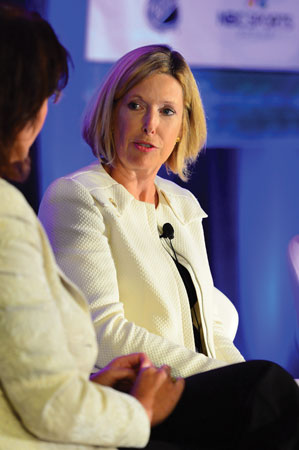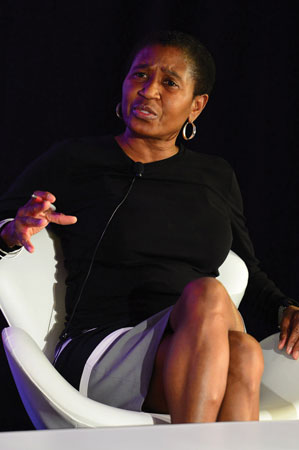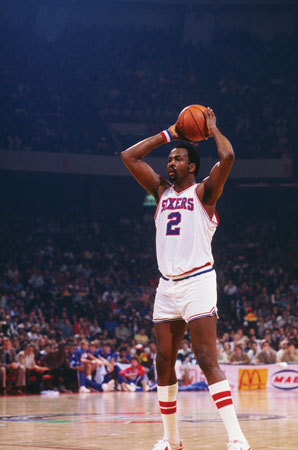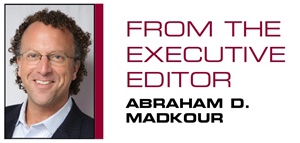After our Game Changers conference last year, I wrote that more men needed to attend and participate in the event in order to have a more honest debate about the business viability of women’s sports. Feedback from high-level attendees implored us to have more decision-makers in the room, people who can influence change.
That was our goal this year, as we tweaked our content to focus a bit more on the business prospects of women’s sports and a bit less on career advancement (the mix was probably 70-30). The results were noticeable in the transparent honesty of speakers who offered an unvarnished assessment of where things stand. While 2015 may have been the summer of women’s sports, there are significant challenges ahead.
Few were as honest as NBA Commissioner Adam Silver, who, along with Rick Welts and Val Ackerman, developed the business plan for the WNBA in the early 1990s. When I asked about the league’s progress, I anticipated that he would offer a scripted response about meeting goals and filling a valuable niche in the sports landscape. But he didn’t. “I thought we’d be further along at this point,” he said to a surprised audience. “I thought ratings would be higher, attendance would be higher by now. I thought we would have broken through. I don’t know how else to say it.”
Silver took responsibility and pointed first to the league’s internal struggles, saying, “In terms of our marketing overall, we may have lost our way at certain points,” while later adding, “The onus is on us as a league to do a better job with [the] imaging. … I think that we need to do things that demonstrate that these women are multidimensional.”
But he also fired a warning to the information “gatekeepers” in pop culture — specifically noting major market dailies and SportsBusiness Journal/Daily — that they risk being out of touch with societal trends if they don’t change their approach to covering women’s sports. “People in positions of power have to make a decision that it matters,” he said. “We’ve got to do a better job marketing it, and part of that is convincing the gatekeepers that frankly they ignore it at their peril. And they will be judged accordingly.”
It’s a fair point, one echoed that day by New York Times columnist Bill Rhoden, who bemoaned the lack of coverage of the playoff-bound WNBA Liberty, saying he was among the few media members at the team’s open practice.
 |
Laurel Richie says the WNBA is “fundamentally a sports and entertainment vehicle.”
Photo by: MARC BRYAN-BROWN
|
The other major debate was the positioning of the WNBA and other women’s sports as cause versus entertainment vehicle. That’s important, because I can’t tell you how many times team operators have expressed frustration about the viability and business behind the “W.” Many lament to me the local resources and staffing they need to put behind the league when they are uncertain there is a niche to be filled or a viable business. That’s resulted in the product being positioned often as a cause.
Well, which is it?
The consensus seemed to be a mix of both. WNBA President Laurel Richie said that, in the past, the league’s pitch to potential partners might have positioned the WNBA as “too much as a cause.” That needs to change, she said. “We are fundamentally a sports and entertainment vehicle,” she said. “We cannot lose sight of that. That’s where our sustainable growth comes from.” Silver agreed, and when I mentioned that very few of the 12 teams are profitable, he remained steadfast. “This isn’t a charity,” he said, “and, if done properly, we are creating asset value in terms of our teams, and, over time, these teams will run cash positive.”
But perhaps the biggest challenge facing all the stakeholders is that women need to do a better job supporting women’s sports. Silver acknowledged his frustration in finding that audience, as 47 percent of the NBA’s audience is female compared with 34 percent of the WNBA’s audience. “Where we haven’t broken the coding, in many ways, is how we can convince women, especially, frankly, young women, which would be most powerful from a marketing standpoint, to be interested in watching women who are often roughly their same age and generation play basketball,” he said.
Earlier in the day, Management Plus Enterprises CEO Leonard Armato riled up the room, which was more than 85 percent female, by saying, “With the exception of a Women’s World Cup, where the nation’s pride is on the line, or the Olympic Games, women’s sports cannot attract a mass audience on television. The reason that they can’t is because women don’t watch other women play sports on television. Women watch men.”
The familiar elements continue to haunt women’s sports. Women watch men’s sports in greater numbers than women’s sports; men are largely the decision-makers at the top media companies determining the amount of coverage of women’s sports; and men are largely the decision-makers at the corporate brands investing sponsorship dollars in sports. In addition, as one longtime female sports executive told me before the conference, “I wish you could somehow get an answer to why more women don’t buy tickets to women’s sports events!”
 |
The NFL’s Dawn Hudson says the industry needs to move faster to get more women into leadership roles
Photo by: MARC BRYAN-BROWN
|
The tone of this year’s Game Changers conference was honest but also underlined with optimism, as 2015 has been a strong year in women’s sports hitting the mainstream. Many panelists kept referring to the growth of women’s sports as being akin to climbing a mountain, and ESPN’s
Stephanie Druley put it well when she said, “We’re midway [up] the mountain, and it gets a little steeper as you keep going. But there’s a climb happening.”
> AT THE EXECUTIVE LEVEL: Another interesting discussion was about the role of women in senior positions in sports and how the numbers compare to corporate America. Four high-level executives differed slightly on whether the sports industry was behind in its hiring of women in senior leadership positions. “When I walk into the sports industry, I still feel like I’ve walked 20 years back to where corporate America has traveled,” said NFL Chief Marketing Officer Dawn Hudson, who joined the league in 2014 after five years at The Parthenon Group and 11 years at PepsiCo. “It’s not nearly where it needs to be, and the industry needs to move faster.”
NBA Chief Marketing Officer Pam El said she was encouraged by the number of women in the leadership ranks at the NBA, compared to her days on the brand side at State Farm. “I believe our league is a little more diverse than others, and that is why it feels different to me,” she said. “The other organizations I have been a part of have less women involved than the NBA.”
 |
The NBPA’s Michele Roberts was pleased with the number of women at the NBA.
Photo by: MARC BRYAN-BROWN
|
National Basketball Players Association Executive Director
Michele Roberts, who joined the sports industry last year after more than three decades in law, said she has been surprised at the number of women but is still assessing the industry. When she joined the NBPA, she said, “I didn’t have any sense there would be any women in the room — ever, ever, ever. I was delighted to see a lot of women in the league at the NBA.” But she did wonder if diversity is changing enough at the highest levels of sports. “I will be interested in what the room will look like during serious negotiations,” she said.
The sports industry is losing one of its highest-ranking female executives with the resignation of Stacey Allaster from the WTA Tour, and the direction that board takes in naming her replacement will be a key story to watch in executive hiring.
Meanwhile, the benefits of a diverse work environment were continually stressed. “A diversity of personality and opinion leads to better decision-making,” Hudson said. “We just have to play catch-up. But the power of the sports platform means we can supercharge this effort.” WWE’s Michelle Wilson also implored organizations to diversify in hiring. “Having different perspectives in the room is key because women bring different decision-making skills.” Earlier in the day, Silver offered his suggestion to people in the room on hiring practices, saying, “If you’re somehow, even if it’s subconsciously, discriminating in some way by only hiring from a certain pool of applicants, you’re not going to be able to compete as well in the marketplace.”
■ ■ ■
A few thoughts from a quick trip to the Bay Area, where I visited the Warriors in Oakland and spoke at the 2015 Sports Summit at Levi’s Stadium:
> THE WARRIORS DID IT!: I’ve written frequently of my respect for the Golden State Warriors’ organization, including President and COO Rick Welts, CMO Chip Bowers, and many others, as smart, progressive and diverse talent permeates the front office. I caught up with Welts one day before he and team general manager Bob Myers were speaking at Salesforce’s Dreamforce convention and discussing the topic of Building a World-Class Organization. Welts gave me a preview of the video he was unveiling at the event, an animation of the team’s proposed privately financed, 18,500-seat arena in the Mission Bay neighborhood that will run well over $1 billion. A day later, he told the thousands in attendance about the 12-acre, mixed-use project that he believes will serve as “the Madison Square Garden of the West.” “It’s going to be the gathering place for San Francisco that we’ve never had before,” he said. You can watch their Dreamforce appearance here. It’s worth the click.
> A PREVIEW OF 50: I took in my first game at Levi’s Stadium, and the 49ers’ season-opener on a Monday night had the feel of a family reunion as many of the team’s greats of years past, including Eddie DeBartolo, Joe Montana, Jerry Rice and Steve Young, lined the field to honor new hall of famer Charles Haley, who was given his Pro Football Hall of Fame ring by Executive Director David Baker. While one game doesn’t represent a true sample size, the facility flowed and functioned well. The building has a number of open, communal spaces, solid sight lines, and kept the sound better than I anticipated. The club level is one of the most spacious, open and airy that I have encountered. Even the heavily scrutinized field was in good shape.
The venue should play well on Super Sunday, Feb. 7, and in talking with executives planning for Super Bowl 50, the two concerns related to the game’s success are familiar: traffic and weather. While a transit line drops passengers off at Levi’s Stadium, officials said they will be careful not to overemphasize that fans take public transportation. They pointed to Super Bowl XLVIII at MetLife Stadium, which was dubbed the first mass-transit Super Bowl — and so many fans followed the message that it resulted in overcrowding and brutally long lines for the metro system. So look for officials to tout a more balanced, multi-pronged approach, with public transport mixed with the 25,000-plus available parking spaces and partnerships with ride-sharing services Uber and Lyft. For the weather, El Niño was mentioned to me more than once, as climate experts say a strong El Niño is building and forecasts suggest wet conditions will linger in the state through the next several months.
In terms of a legacy piece, keep an eye on Super Bowl Host Committee CEO Keith Bruce’s efforts to make Super Bowl 50 the most philanthropic Super Bowl ever. Grants to Northern California nonprofits from the 50 Fund, a charitable organization launched in December, are set to top the $10 million doled out by the host committee of the 2014 Super Bowl in New York and New Jersey. Having three major cities in San Francisco/Oakland/San Jose and the bevy of well-funded tech companies in the region surely helps his efforts. The committee already has raised $8 million and dispersed $4 million in grants, a rare example of giving grants before the game. Also look for the host committee to bring a heavy tech focus to the experience, with partners like Intel, Yahoo and Google, as well has being the first host committee to have its own app. Finally, I really like the committee’s 50 Tour: Champions of the Bay, a mobile tour showcasing the eight Lombardi trophies (five for the 49ers, three for the Raiders) won by Bay Area teams. The 12-week tour makes stops in different markets across the Bay Area each weekend. I have a lot of respect for Bruce, who brings a sharp mind and strong organizational skills to the Bay Area effort.
 |
Moses Malone stood tall for the 76ers.
Photo by: GETTY IMAGES
|
> MOSES MALONE WAS ONE COOL CAT: I felt a kick in my stomach on the morning of Sunday, Sept. 13, when I read that
Moses Malone had died suddenly at age 60. A hero of my generation was gone too soon. I absolutely marveled at the way the indefatigable Malone played the game. Growing up, I loved
Dr. J and rooted fervently for the 76ers, so I’ll never forget the magical year when Malone arrived in Philadelphia and carried a good but never great 76ers team on his back to 65 regular-season wins and an amazing 12-1 postseason run. I remember pacing a TV room in Vermont, imploring to a TV screen, “Lead them, Moses!” I was enthralled by his tireless effort in going after the basketball, his rugged moves, soft hands, flick-of-the-wrist jumpers and the sweat that would pour off his face when he stood at the foul line after being hammered time and again by an opponent. I’ll never forget how angry I was in 1986 when I learned the 76ers had traded the rough and rangy Malone to the Washington Bullets for
Jeff Ruland and
Cliff Robinson, one of the worst trades in the modern era. I never met Malone, but wish I could have told him how much he inspired me to work hard on the court, attack the rack, and embrace the dripping sweat that comes from such efforts.
Abraham D. Madkour can be reached at amadkour@sportsbusinessjournal.com.








